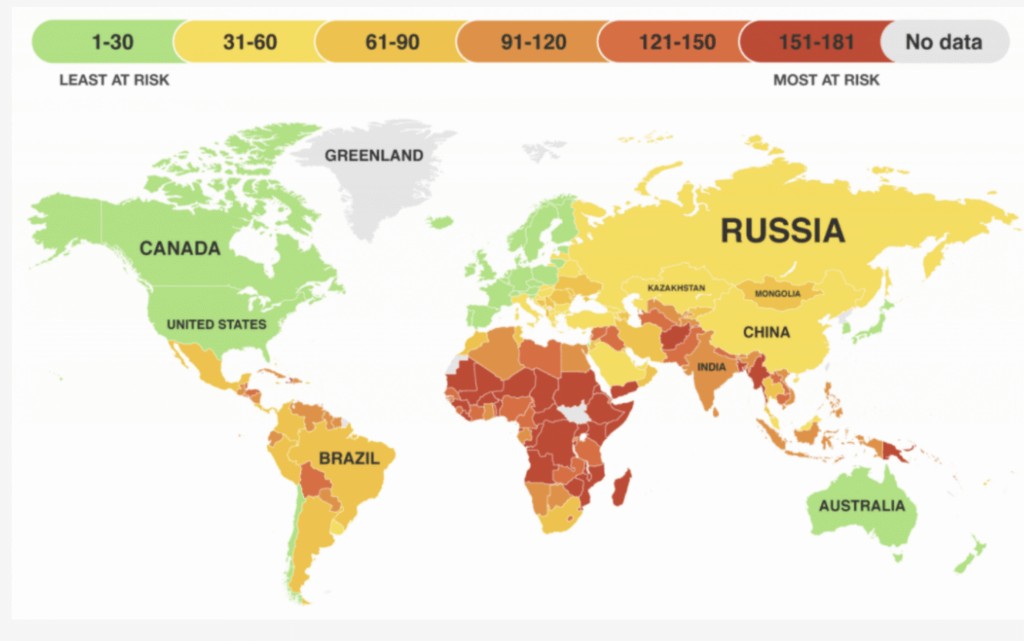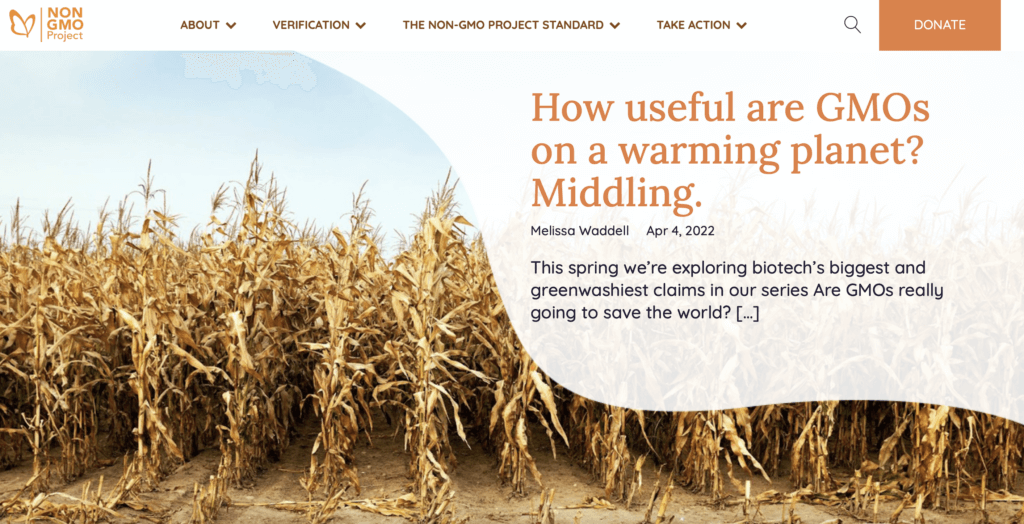
Temperatures in Africa are projected to rise faster than the global average, with estimates ranging from an increases of 0.2℃ per decade at the low end to more than 0.5℃ per decade at the high end. Some climate change skeptics and politicians, such as Lamar Smith, a Republican former Texas representative and chair of the House Science Committee until he retired in 2018 to become a lobbyist, have argued that crops yields might actually increase in more far northern and southern climes, offsetting the vulnerability in Africa, India and other regions, and warming.
Not so fast. There’s no question that climate change will change crop yields around the world. Models used by scientists and other organizations like the Intergovernmental Panel on Climate Change (IPCC) predict that if the current rate of changing climate continues, crop yields in lower-latitude regions will decrease, while upper-latitude yields will rise. And as described by NASA, higher carbon dioxide levels are to increase crop yields by “increasing the rate of photosynthesis, which spurs growth, and they reduce the amount of water crops lose.”
Long-term negative impacts on crops from rising temperatures?
But whatever benefits rising temperatures might confer in some areas will soon wane as warming increases. It’s predicted that extreme heat, changing rainfall and other climate change impacts will make it harder to grow staple crops in the most productive farming regions such as the United States as soon as 2020. And many of the studies claiming positive impacts leave out a little-studied phenomenon that accompanies changes in climate — changes in the types and prevalence of crop diseases.
Researchers from the universities of Exeter and Utrecht looked at crop-climate models and factored in the risks of crop pests. A 2021 paper in Nature Climate Change found that by looking at rises in temperature, they could track how 80 fungal pathogens reduced yields in 12 major crops during the course of this century.
They found that the benefits of yield gains could be reduced—and in some cases eliminated—by the concurrent increases in crop diseases in higher-latitude farms. According to the researchers:
Crop disease burdens could track crop responses, increasing at higher latitudes where climate change is project to boost yields. Further, the suite of crop diseases that farmers face in some of the world’s most productive regions will change dramatically. … Agriculture must therefore prepare accordingly if any potential benefits of climate change for crops yields are to be realized.
But how?
What tools could be deployed?
According to the Broad Institute’s Alliance for Science, gene editing could be a powerful answer by tweaking the genetics of crops to make them more resilient to the effects of climate change:
- Managing disease—As we’ve noted so far, higher temperatures mean surges in disease. Kenyan researchers, meanwhile, applied CRISPR technology to inactivate banana streak virus, which is activated by drought and extreme heat.
- Tolerating drought—Dry soil and scarce rainfall will increase under climate change scenarios, especially in lower-latitude areas (but higher-latitudes are not immune). By targeted genes that can enhanced effects of these stresses, CRISPR-Cas gene editing could disrupt these genes and enable stronger growth of crops in the face of drought.
- Boosting yields—Traditional breeding techniques, applied strategically, can increase crop yields. In addition, CRISPR-Cas9 has produced rice with 11 to 68 percent yield increases, increased the size of tomatoes and created greater livestock muscle mass.
- Surviving in saline soil—Salinity is considered another symptom of climate change, and severely hinders plant growth. Low-quality irrigation will probably exacerbate the problem. In response, CRISPR has been used to increase salinity tolerance in tomatoes, and, in China, eliminate a rice gene to improve tolerance to elevated soil salts.
- Fending off weeds—The Number One enemy of crop farmers, weeds can reduce crop yields by more than 30 percent. Rising carbon dioxide concentrations and changes in precipitation and temperature will no doubt usher in faster weed growth. While new chemicals could help stem weed growth, CRISPR editing has introduced an herbicide-tolerant gene variation (allele) in rice, which could allow farmers to practice no-till agriculture which itself reduces greenhouse gas emissions.
How would pathogens make their way into high-latitude plants?
Basically, higher latitude plants would be no less immune from pathogen infections than crops at lower-latitudes. Diseases are mostly controlled by temperature, light and water. Sunlight boosts the accumulation of phytoalexins (which fight off parasites) and protective pigments in pathogens. Water, of course, can allow physical spread as well as assist in reproduction and enhanced development of some pathogens (others, however, can survive better in more arid conditions). And then, temperature can increase susceptibility to rusts, and boost the occurrence of bacteria. Changes in climate, according to a team of plant biologists at the University of Kashmir:
…may result in geographical distribution, increased overwintering, changes in population growth rates, increases in the number of generations, extension of the development season, changes in crop-pest synchrony of phenology, changes in interspecific interactions and increased risk of invasion by migrant pests.
These changes, however, may not rise in a straight line by increasing with every degree rise in temperature. Princeton University researchers modeled the effects of climate change on the fungal “flax rust” (Melampsora lini) and its host plant, the Lewis flax, a subalpine wildflower. Their study in Scientific Reports showed that climate change would first slow transmission of the flax rust, but the pathogens would resurge and spread as warming continued to increase. How would this happen? The researchers believe that first, warmer temperatures would inhibit plant growth, which would cause a drop in disease spread, at least temporarily.
“This will lead to a drop in infection risk due to both a reduction in spore dispersal and a decrease in the odds that a plant becomes infected when challenged with fungal spores,” they wrote. But, they added, “Rebounds in plant growth, infection intensity progression, infection risk and epidemic pace are all predicted to occur after the initial deceleration.”
Crop biotechnology rejectionists argue against technology-based solutions
While many environmental groups advocate for deploying biotechnology to address crop climate change dislocations, numerous environmental groups reject the scientific consensus that GMOs or gene editing could play any role in stabilizing crop yields. In one of many rejectionist “reports”, the Non-GMO Project, whose revenues are based on demonizing crop biotechnology, argued in a blog post soliciting donations that the potential benefits of GMOs and gene-edited crops to help address agricultural climate change dislocations was one of the biotech industry’s “greenwashiest claims“.
We hear again and again that #GMOs are necessary to feed a growing population on a warming planet, but does the evidence hold up? Not exactly. This #ClimateWeek, we’re bringing back a blog that busts some of biotech’s biggest and greenwashiest claims. In recent decades, a truly dizzying amount of money has been spent under the banners of philanthropy and international aid. Programs such as AGRA (A Green Revolution for Africa) offer hybrid seeds and fertilizers, while WEMA (Water Efficient Maize for Africa project) supplies high-yielding corn (or maize) seed and, more recently, GMOs.
Despite these and other programs, success remains elusive. … We believe that the best solutions are based on local and Indigenous knowledge, evolving with the participation of small farmers. These solutions emerge with deep respect for the social and economic impacts of both action and inaction, they prioritize equity and autonomy, and they value food sovereignty over profit.
Science doesn’t support that fantasy. As science journalist Cameron English has reported, “According to the Consultative Group for International Agricultural Research (CGIAR), more than 100 drought-tolerant maize varieties have been released in 13 African countries since 2006. Field trials showed that these crops can increase yields by as much as 35 percent. Two million farmers in sub-Saharan Africa currently grow these maize varieties, and the results, as reported in the study, have been impressive:
Farmers are reporting yields 20–30% above what they would have gotten with their traditional varieties, even under moderate drought conditions. If farmers continue to adopt the technology, the project has the potential to reap nearly USD 1 billion in benefits to farmers and consumers.
And as another study focused on Zambia reported, the benefits of increased food security would go mostly to the poorest of the poor:
DT [drought tolerant] maize seeds gives an extra income of US $240/ha [hectare] or more than nine months of food at no additional cost. This has huge implications in curbing food insecurity and simultaneously saving huge amounts of resources at the household and national levels …
Mainstream scientists and environmentalists continue to advocate a holistic approach to addressing climate change, and its disease effects on higher-latitude yields. That means we need all the help we can get — which includes advanced agricultural technologies.
Andrew Porterfield is a writer and editor, and is a contributing agriculture editor at the Genetic Literacy Project. He has worked with numerous academic institutions, companies and non-profits in the life sciences. BIO. Follow him on Twitter @AMPorterfield
































